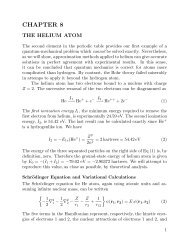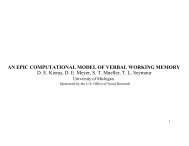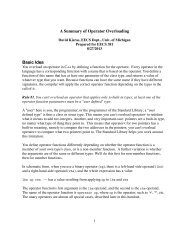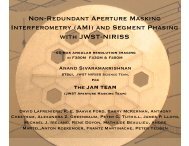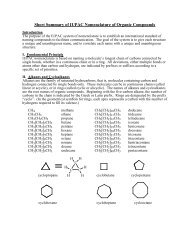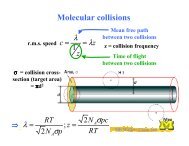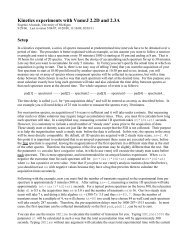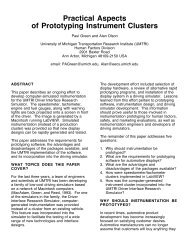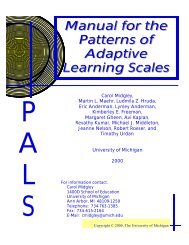Chapter 7. Exercises
Chapter 7. Exercises
Chapter 7. Exercises
Create successful ePaper yourself
Turn your PDF publications into a flip-book with our unique Google optimized e-Paper software.
<strong>Chapter</strong> <strong>7.</strong> <strong>Exercises</strong><br />
1. Assume that each circular Bohr orbit for an electron in a hydrogen<br />
atom contains an integer number of de Broglie wavelengths, n = 1, 2, . ...<br />
Show that the orbital angular momentum must then be quantized. Bohr’s<br />
formula for the hydrogen energy levels follows from this.<br />
2. Based on your knowledge of the first few hydrogenic eigenfunctions,<br />
deduce general formulas, in terms of n and l, for: (i) the number of radial<br />
nodes in an atomic orbital; (ii) the number of angular nodes; (iii) the total<br />
number of nodes.<br />
3. Calculate the wavelength of the Lyman alpha transition (1s ← 2p) in<br />
atomic hydrogen and in He + . Express the results in both nm and cm −1 .<br />
4. Determine the maximum of the radial distribution function for the<br />
ground state of hydrogen atom. Compare this value with the corresponding<br />
radius in the Bohr theory.<br />
5. The following reaction might occur in the interior of a star:<br />
He ++ + H → He + + H +<br />
Calculate the electronic energy change (in eV). Assume all species in their<br />
ground states.<br />
6. Which of the following operators is not equal to the other four: (i)<br />
∂ 2 /∂r 2 (ii) r −2 ∂/∂r r 2 ∂/∂r (iii) r −1 ∂ 2 /∂r 2 r (iv) (r −1 ∂/∂r r) 2<br />
(v) ∂ 2 /∂r 2 + 2r −1 ∂/∂r.<br />
<strong>7.</strong> Calculate the expectation values of r, r 2 and of r −1 in the ground state<br />
of the hydrogen atom. Give results in atomic units.<br />
8. Calculate the expectation values of potential and kinetic energies for the<br />
1s state of of a hydrogenlike atom.<br />
9. Verify that the 3d xy orbital given in the table is a normalized eigenfunction<br />
of the hydrogenlike Schrödinger equation.<br />
1
10. Show that the function<br />
ψ(r,θ,φ) = const [ 1 − r sin 2 (θ/2) ] e −r/2<br />
is a solution of the Schrödinger equation for the hydrogen atom and find<br />
the corresponding eigenvalue (in atomic units).<br />
11. For the ground state of a hydrogenlike atom, calculate the radius of the<br />
sphere enclosing 90% of the electron probability in the 1s state of hydrogen<br />
atom. (This involves a numerical computation with successive approximations.)<br />
12. Consider as a variational approximation to the ground state of the<br />
hydrogen atom the wavefunction ψ(r) = e −αr . Calculate the corresponding<br />
energy E(α) then optimize with respect to the parameter α. Compare with<br />
the exact solution.<br />
13. The electron-spin resonance hyperfine splitting for atomic hydrogen is<br />
given by<br />
∆ν = 532.65{ 8π<br />
3 |ψ(0)|2 +<br />
〈 3cos 2 θ − 1<br />
r 3 〉}<br />
MHz<br />
Calculate ∆ν for the 1s and for the 2p 0 states. The result is in MHz when<br />
the bracketed terms are expressed in atomic units. (Hint: In the expectation<br />
value, do the integral over angles first.)<br />
2
<strong>Chapter</strong> <strong>7.</strong> Solutions<br />
1. De Broglie wavelength λ = h/p with L = r p. Circumference of orbit<br />
2πr = nλ, an integer number of wavelengths. This implies L = nh/2π = n¯h.<br />
2. n − l − 1 radial nodes, l angular nodes, n − 1 total nodes.<br />
3. The best formula to use is<br />
1<br />
λ = Z2 R<br />
( 1<br />
n 2 1<br />
− 1 n 2 2<br />
where R is the Rydberg constant, 109678 cm −1 . For hydrogen, 1/λ =<br />
R(1/1 2 −1/2 2 ) = 82258.5cm −1 , λ = 121.6nm. For helium, 1/λ = 4 R(1/1 2 -<br />
1/2 2 ) = 329034cm −1 , λ = 30.39nm.<br />
)<br />
4. Find the maximum of D 1s (r) = 4πr 2 [ψ 1s (r)] 2 = const r 2 e −2Zr . Set<br />
dD/dr = 0, giving r max = 1/Z (= a 0 /Z), same as Bohr radius for 1s orbit.<br />
5. He ++ and H + are bare nuclei so their electronic energies equal zero.<br />
He + and H are hydrogenlike so their 1s energies equal −Z 2 /2. Thus ∆E =<br />
−4/2 + 1/2 = −3/2 hartrees = −40.8 eV.<br />
6. (i). The other four operators are equal.<br />
<strong>7.</strong><br />
〈r〉 =<br />
∫ ∞<br />
0<br />
ψ 1s (r) r ψ 1s (r) 4πr 2 dr = 3 2<br />
(<br />
= 3 )<br />
2 a 0<br />
〈r 2 〉 =<br />
∫ ∞<br />
0<br />
ψ 1s (r) r 2 ψ 1s (r) 4πr 2 dr = 3<br />
(<br />
= 3a<br />
2<br />
0<br />
)<br />
3
∫ ∞<br />
〈r −1 〉 =<br />
0<br />
ψ 1s (r) r −1 ψ 1s (r) 4πr 2 dr = 1<br />
(= 1 a 0<br />
)<br />
8. Average potential energy:<br />
< V >=<br />
∫ ∞<br />
0<br />
ψ 1s (r)<br />
(<br />
− Z )<br />
r<br />
ψ 1s (r) 4πr 2 dr = −Z 2<br />
Average kinetic energy:<br />
< T >=<br />
∫ ∞<br />
0<br />
ψ 1s (r)<br />
(− 1 2 ∇2 )<br />
ψ 1s (r) 4πr 2 dr = Z 2 /2<br />
More simply, since total energy E 1s = −Z 2 /2, 〈T〉 = E 1s − 〈V 〉. Note that<br />
〈V 〉 = −2〈T〉, consistent with the virial theorem.<br />
9. For an easier exercise, do the 2p z orbital instead.<br />
10. You should find that this function solves the Schrödinger equation with<br />
E = −Z 2 /8, i.e., n = 2. For normalization<br />
const = Z3/2<br />
4 √ π<br />
Noting that sin 2 (θ/2) = (1 − cosθ)/2, the function is found to be an s-p<br />
hybrid orbital:<br />
ψ = √ 1 (ψ 2s + ψ 2pz ) 2<br />
4
11. Solve for R: ∫ R<br />
|ψ 1s (r)| 2 4πr 2 dr = 0.9<br />
or easier<br />
0<br />
∫ ∞<br />
We find, using integral table,<br />
∫ ∞<br />
4<br />
R<br />
R<br />
|ψ 1s (r)| 2 4πr 2 dr = 0.1<br />
r 2 e −2r dr = e 2R (1 + 2R + 2R 2 ) = 0.1<br />
Solving numerically, R = 2.6612a 0 = 1.41 Å.<br />
12. Let ψ(r) = e −αr . Then<br />
E(α) =<br />
∫ ∞<br />
0<br />
e ( −αr − 1 2 ∇2 − Z/r ) e −αr 4πr 2 dr<br />
∫ ∞<br />
0<br />
e −2αr 4πr 2 dr<br />
= 1 2 α2 − Zα<br />
E ′ (α) = 0 for minimum, giving α = Z. Thus ψ(r) = e −Zr and E = −Z 2 /2,<br />
which in this exceptional case equal the exact eigenfunction and eigenvalue.<br />
5




